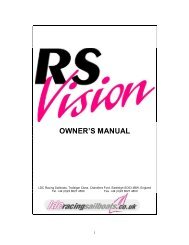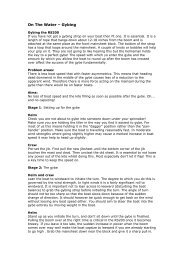rs200 owner's manual - Rs Sailing
rs200 owner's manual - Rs Sailing
rs200 owner's manual - Rs Sailing
You also want an ePaper? Increase the reach of your titles
YUMPU automatically turns print PDFs into web optimized ePapers that Google loves.
surprised how fast she can tack and you may need a little time to get used to<br />
pushing the tiller extension in front of you, Laser style, as you start the tack.<br />
Don’t try to take it round the back, it won’t go! Try some gybes, in any wind<br />
you will find the gybeing line described above most useful for pulling the boom<br />
over and that just the right amount of rudder correction is required coming out<br />
of the gybe.<br />
Setting the fore and aft sails<br />
The following are helpful generalisations to guide the relatively inexperienced.<br />
Further advise and information is available in subsequent sections to help you<br />
get the best racing performance from your RS200.<br />
The jib<br />
Once hoisted and a firm but not ridiculous tension is applied to the rig the only<br />
adjustment necessary is to position the jib fairleads. By and large if the rake<br />
has been set up as suggested in ‘stepping the mast’ then a middle position<br />
should not be far out. The jib has a fairly narrow sheeting angle and<br />
consequently the crew should be careful not to over sheet the jib.<br />
In most conditions the jib should be set as closely as possible yet allowing the<br />
leach to take a slight curve in sympathy with the shape of the mainsail. There<br />
is no hard and fast rule, only practice and experience will find the correct<br />
setting for all conditions. Observation of the telltales will go a long way to<br />
helping find the correct setting. When the jib is correctly set these should all<br />
respond pretty well in unison, if you have difficulty in achieving this then try<br />
moving the fairleads a little fore and aft as follows:-<br />
If the top leeward telltale tends to collapse before the others then ease the<br />
sheet a little (by little read 1cm or so), if this causes the foot of the jib to get<br />
significantly fuller then move the fairleads aft. If the top windward tell tale<br />
tends to lift well before the others then sheet a little harder or if this has little or<br />
no effect then move the fairleads forward. In very light and in strong winds the<br />
fairleads should be moved a hole or so aft of the optimum to encourage the<br />
leach to open. The RS 200 is fundamentally a pointing boat; so even in<br />
moderate winds the top windward telltale should lift a fraction before the<br />
others and the boat generally sailed to windward such that all windward tell<br />
tales are lifting a little.<br />
The mainsail<br />
To windward in all but the most extreme conditions the mainsail should be<br />
sheeted close to the centreline. To this end the length of the mainsheet bridle<br />
should be adjusted in order to optimise this across the wind range. Adjust the<br />
clew outhaul so that it just takes the slack out of the foot of the sail. Only ease<br />
it when off the wind or when looking for that extra bit of power in say moderate<br />
winds and a choppy sea, and then only a little. You may pull it tight once<br />
overpowered especially on flat water.<br />
In most conditions sheet the mainsail solely with the mainsheet, the kicking<br />
strap should remain slack and only come into play when the mainsheet is<br />
12




